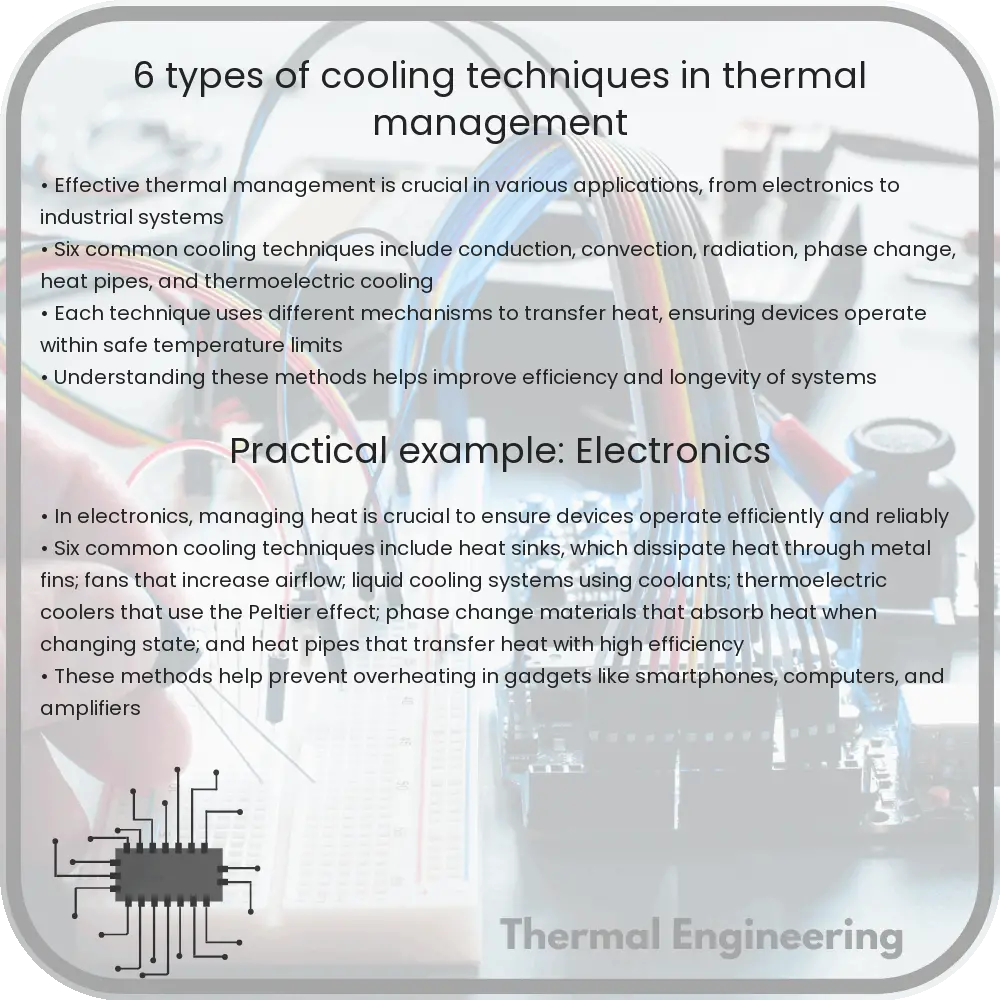This article delves into six crucial cooling techniques used in thermal management across various industries to ensure optimal operation and longevity of systems.

Introduction to Cooling Techniques in Thermal Management
Thermal management is a critical aspect of engineering, particularly in electronics, automotive, aerospace, and HVAC systems, where efficient heat dissipation is crucial for reliable operation and longevity. Overheating can result in reduced performance, failures, and safety issues. This article explores six principal cooling techniques used across various industries to manage heat effectively.
1. Air Cooling
Air cooling is one of the simplest and most common methods used to dissipate heat. It involves the flow of air, often facilitated by fans or blowers, across a heated surface to lower its temperature. The effectiveness of air cooling depends on the air velocity, ambient temperature, and the properties of the air flow path.
- Advantages: Low cost, simplicity, and minimal maintenance requirements.
- Disadvantages: Limited cooling capability, which can be insufficient for highly dense or high power devices.
2. Liquid Cooling
Liquid cooling involves the circulation of a coolant in close proximity to hot components. The coolant absorbs heat from the component and then dissipates it through a radiator or heat exchanger. Liquids have a higher heat capacity and can remove heat more efficiently than air.
- Advantages: More efficient in removing heat due to higher heat capacity of liquids.
- Disadvantages: More complex installation, higher costs, and potential for leaks.
3. Heat Sinks
Heat sinks are passive cooling devices that increase the surface area in contact with the cooling medium, such as air or liquid. They are typically made from metals with high thermal conductivity, such as aluminum or copper. Heat sinks utilize fins or pins to enhance the heat transfer rate by convection.
- Advantages: Simple, no moving parts, reliable, and cost-effective for moderate cooling needs.
- Disadvantages: Effectiveness is limited by the ambient temperature and airflow; not suitable for extremely high heat fluxes.
4. Thermoelectric Cooling (Peltier Cooling)
Thermoelectric coolers operate on the Peltier effect, where heat is absorbed or released when an electric current passes through a junction of two different materials. This method can be used for precise temperature control.
- Advantages: Provides both cooling and heating, precise temperature control, compact and no moving parts.
- Disadvantages: Low energy efficiency and high cost in larger applications.
5. Phase Change Materials (PCMs)
PCMs absorb and release thermal energy during the process of melting and solidifying at a specific temperature. They are used to mitigate temperature fluctuations and manage transient thermal loads.
- Advantages: Effective in stabilizing temperature variations and storing thermal energy.
- Disadvantages: Integration and containment can be challenging; limited by the phase change temperature range of the material.
6. Spray Cooling
Spray cooling uses a sprayed, fine mist of coolant directly onto a hot surface, where it evaporates rapidly, taking away a significant amount of heat due to the latent heat of vaporization. This is often used in high-performance applications like power electronics and high-speed computing.
- Advantages: Extremely efficient at removing high heat flux densities.
- Disadvantages: Can be complex to implement, requires careful management of the coolant and can be expensive.
Conclusion
Choosing the right cooling technique in thermal management depends on a variety of factors including environmental conditions, space constraints, budget, and specific application needs. Understanding the advantages and limitations of each method provides a foundation for engineers to design more effective and efficient cooling solutions for any given application.